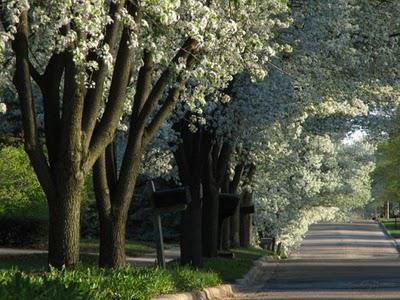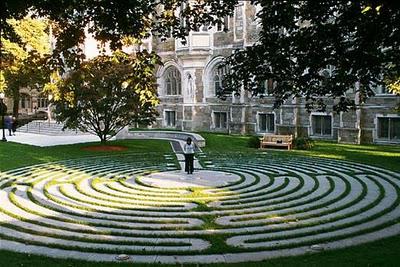
Shady Grove by Karen Casey Smith
The last few days we had a break in the winter weather and like many people I found myself out for a walk. Where I live in the New York Metro area, walking, like everything else, seems to have be for a specific purpose or reason in order for people to engage themselves. Usually a walk means someone has to catch the train or bus, squeeze in some exercise time (because it's "good" for you) or in our neighborhood take the kids to the park. I occasionally meet someone just out for enjoyment, but not too often. That said, people here "do" walk. They are out and about all the time.I was thinking about all this recently and I remembered an article I read last year in Llewellyn's 2010 Magical Almanac, "Walking with Spirit" by Harmony Usher. In the article, Usher maintains that walking is both a physical and symbolic activity that connects our bodies and spirits with moving forward. When we move the body, we quiet the mind. Our circulatory system gets going, we change our scenery and our spirit blossoms. We are able to view life from a different perspective.
What I enjoyed about reading "Walking with Spirit" was Usher's discussion of seven different types of spiritual walking in which she describes the purpose of each and their intent. Some of these can be combined with others, but it's still an interesting list to read and think about. Below is Usher's spiritual walking list. Some of the descriptions were derived from her article, others are from my own observations and research.
1. Walkabouts. The walking spiritual tradition that native Australians have been practicing for centuries. During a solitary period in the desert the walker enters into a meditative state during which they connect deeply to the land and their individual spirit guide, who eventually leads them home. The walker communes with nature and connects with the spiritual realm.
2. The Pilgrimage, in which the seeker travels by foot to reach a specific place. In these journeys, once again, it is not only the physical expedition that is of importance, but inner spiritual voyage as well. A good example of a Pilgrimage in the United States is the yearly Easter Pilgrimage to Chimayo in Northern New Mexico. Thousands of people participate in this event. Some leaving their homes and walking as far as 90 miles during Holy Week to reach the Sacred Chapel of Chimayo.
3. While pilgrimages and walkabouts require time and physical energy, Buddhists around the world undertake a practice called Walking Meditation where the walker pays attention to the walking process.
Walking Meditation develops balance and accuracy of awareness as well as durability of concentration.
The focus of a Walking Meditation is not fitness, but the act of breaking down the walking process into individual smaller movements that allows the consciousness to expand.

BC Memorial Labyrinth
4. Labyrinth walking has skyrocketed in popularity over the last few years through healing centers, spas and retreats as means to relieve stress. Walking the Labyrinth is the practice of journeying to and then returning from the center. A Labyrinth has a clearly marked path to follow ascending towards salvation or enlightenment for meditation, prayer, relaxation. Popular in the Middle Ages, Labyrinths were often created in Churches but the symbol has appeared in a variety of ancient cultures from around the world. In Celtic tradition they have been found etched in the entrances and chambers of ancient Neolithic tombs. A Labyrinth is continuous and always begins where it ends. While a maze has many turns and blind alleys, a Labyrinth always traces a single path, in and out of the center. They are associated with rebirth and the afterlife.5. In Mindful Walking one opens up their senses and engages themselves in the present moment. You become conscious of where you are, what you are doing, how you feel, how your senses feel and what is around you. What you do not do is have a conversation with your brain about it. You hear what is around you, you see what is around you...you experience. Mindful Walking is a bridge between being in a meditative state and being present in the physical moment. This is probably my favorite type of spiritual walking.
6. Ritualistic Walkers engage in some kind of predetermined custom or tradition when they walk. It may be something as simple as walking at the same time everyday, in the same place, for a certain amount of time. Some ritual walkers infuse meaning into their practice, such as beginning their day with a walk at sunrise to usher in positive beginnings. There are also more extreme forms of Ritualistic Walking such as Firewalking in the Indian Culture, associated with the mystical powers of fakirs.
7. And finally there are Gratitude Walks which help us open our hearts to the abundance of the Universe. We give thanks for who we are and all that we have by acknowledging the simple pleasures and beauty in our life. This is something we should all make a regular practice of doing.
Whatever kind of walking you engage in... for fitness, renewal of spirit or enjoyment, just take the time to get out of the house and do it. You will arrive back home with refreshed eyes and a revived spirit that will not only benefit you but those around you as well.
~ diane
You can find the beautiful Shady Grove is by photographer Karen Casey Smith in her Etsy Shop. Thank you for letting me use your Photo Karen!
BC Memorial Labyrinth is from Wiki Commons
Follow the Mind Body Spirit Marketplace on Facebook

